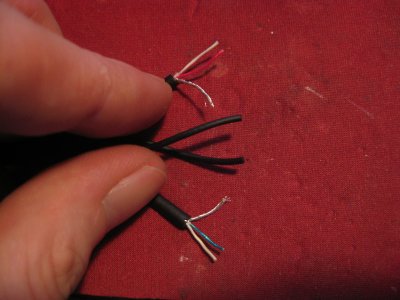Joe Garfield
New member
I want to make a new cable for AKG K712 which has a trs to 3-pin mini XLR. I’ve noticed that typical trs, like headphone extensions, use 2-conductor cable with the shield acting as 3rd conductor (ground in this case.) I’ve also noticed people using 4-core microphone cable.
Using a shield as the ground would result in a different resistance/impedance/capacitance than the positive signal wires. Doesn’t that matter?
Initially I didn’t like the idea because grounding a shield at both ends introduces a ground loop, but I guess in this application there isn’t a second ground path, but you’re still intentionally making an antenna and using it as part of the ac signal path.
Quad core is meant for balanced cable situations - two + and two - wound together so that noise is symmetrical between + and - and therefore can be better handled by balancing. This doesn’t seem to make sense for 2-channel headphones. You could use the two pairs as R+L but then you lose the claimed benefit Of low noise. If used for 2-channel with common ground, you’d end up with ground loops. More interestingly it seems like more room for jitter (time based problems) since partial signals could arrive at different times/levels if the paths are not identical.
However it’s very difficult to find 3 conductor shielded cable in the proper diameters for headphones.
Mogami’s headphone extension is really a balanced mono extension. Hosa’s headphone extension is 2-core with shield as the ground, and they even tell you the shield is less oxygen free than the cores. But audio is AC so why does that make sense?
Using a shield as the ground would result in a different resistance/impedance/capacitance than the positive signal wires. Doesn’t that matter?
Initially I didn’t like the idea because grounding a shield at both ends introduces a ground loop, but I guess in this application there isn’t a second ground path, but you’re still intentionally making an antenna and using it as part of the ac signal path.
Quad core is meant for balanced cable situations - two + and two - wound together so that noise is symmetrical between + and - and therefore can be better handled by balancing. This doesn’t seem to make sense for 2-channel headphones. You could use the two pairs as R+L but then you lose the claimed benefit Of low noise. If used for 2-channel with common ground, you’d end up with ground loops. More interestingly it seems like more room for jitter (time based problems) since partial signals could arrive at different times/levels if the paths are not identical.
However it’s very difficult to find 3 conductor shielded cable in the proper diameters for headphones.
Mogami’s headphone extension is really a balanced mono extension. Hosa’s headphone extension is 2-core with shield as the ground, and they even tell you the shield is less oxygen free than the cores. But audio is AC so why does that make sense?

